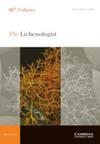巴基斯坦吉尔吉特-巴尔蒂斯坦Deosai国家公园Anamyropora属一新种
IF 1.4
4区 生物学
Q4 MYCOLOGY
引用次数: 0
摘要
摘要从巴基斯坦吉尔吉特-巴尔蒂斯坦Deosai国家公园的三个不同地点采集了一种出现在岩石上的新型地衣。对nrDNA-ITS和nuLSU区域的系统发育分析表明,它聚集在Anamyropora属内。进一步的化学和形态解剖分析证实了它的独特性,并将其描述为一个新物种,名为a.pakstanica。其特征是:不规则的鳞片状附着在岩石上的铊,没有莱茵菌;表皮层,厚度可达25微米;透明的子囊孢子,简单,厚壁,表面光滑;有隔膜的副咽,在凝胶状基质中有色素沉着的顶端细胞;球状到近球形的pycnidia,具透明和杆状pycnidio孢子。特别是,该物种与该属其他成员的区别在于形态解剖特征,包括铊的颜色、厚的下皮层(高达100μm)的存在以及简单的厚壁子囊孢子的存在。标本是在4587米的高度发现的,这是迄今为止报道的Anamyropora的最高海拔。文中还给出了Anamyropsora属所有现存物种的检索表和比较表。本文章由计算机程序翻译,如有差异,请以英文原文为准。
A new species of the genus Anamylopsora (Baeomycetaceae; Ascomycota) from Deosai National Park, Gilgit-Baltistan, Pakistan
Abstract A novel lichen species occurring on rocks was collected from three different localities within Deosai National Park, Gilgit-Baltistan, Pakistan. Phylogenetic analyses of the nrDNA ITS and nuLSU regions revealed that it clustered within the genus Anamylopsora. Further chemical and morpho-anatomical analyses confirmed its uniqueness, and it is described here as a new species under the name A. pakistanica. The distinguishing characters are: an irregularly squamulose appressed thallus on rocks without rhizines; an epinecral layer up to 25 μm thick; ascospores that are hyaline, simple, thick-walled with a smooth surface; septate paraphyses with a pigmented apical cell in a gel-like matrix; globose to subglobose pycnidia with hyaline and bacilliform pycnidiospores. In particular, the species is distinguished from other members of the genus by morpho-anatomical features including the coloration of the thalli, the presence of a thick lower cortex (up to 100 μm), and the presence of simple, thick-walled ascospores. Specimens were found at altitudes up to 4587 m, the highest elevation yet reported for Anamylopsora. A key and comparison to all existing species of the genus Anamylopsora is also given.
求助全文
通过发布文献求助,成功后即可免费获取论文全文。
去求助
来源期刊

Lichenologist
生物-真菌学
CiteScore
2.90
自引率
14.30%
发文量
23
审稿时长
6.0 months
期刊介绍:
The Lichenologist is the premier scientific journal devoted exclusively to the study of lichens worldwide. As the leading forum for the dissemination of new concepts and topical reviews, The Lichenologist reaches more scientists concerned with the study of lichens and lichen symbionts than any other single journal. All aspects of lichenology are considered including systematics and phylogenetics; molecular biology; ultrastructure, anatomy and morphology; secondary chemistry, effects of pollutants and use as bioindicators; biogeography. In addition to standard length research papers, the journal also publishes Short Communications and Book Reviews. A monthly issue may occasionally be devoted to papers deriving from a symposium.
 求助内容:
求助内容: 应助结果提醒方式:
应助结果提醒方式:


